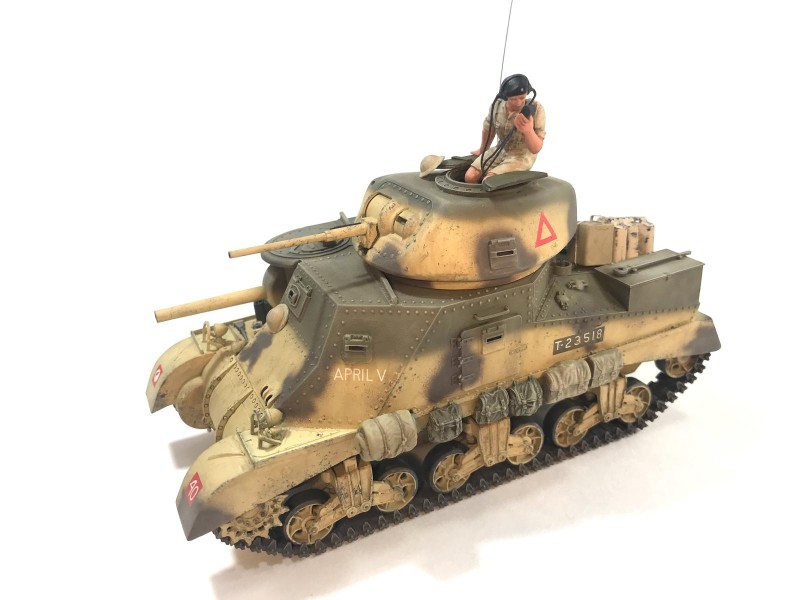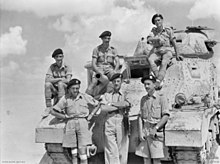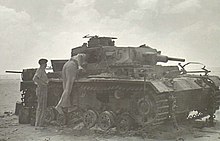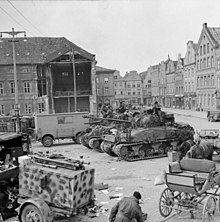 . Second World War
. Second World War
[edit]
1939–1941: Palestine and Syria
[edit]
Still stationed in Palestine, under the command of Lieutenant-Colonel H. N. Todd, the Scots Greys were brought up to war strength following the declaration of war against Germany. Although the German blitzkrieg attacks in Poland, France and the Low Countries demonstrated that the tank was now the dominant weapon, the Scots Greys continued to be equipped with horses.[107]
As the B.E.F. fought in France in 1940, the Scots Greys were retained in the Middle East to police the Mandate. In fact the last mounted cavalry charge on horseback by the Scots Greys occurred in February 1940, when the regiment was called to quell Arab rioters.[107]
At first, the Scots Greys were transformed into a motorised regiment, using wheeled vehicles. Elements of the Scots Greys and Staffordshire Yeomanry formed a composite cavalry regiment assigned to reinforce the divisional cavalry element for Operation Exporter, the invasion of Vichy-held Syria and Lebanon. The remainder of the regiment remained in Palestine, operating in the vicinity of Jerusalem.[108] The composite Grey-Stafford regiment took part in most of the battles of the campaign, including the Battle of Kissoué, where it held off a counter-attack by Vichy French armour.[109]
A final review of the Scots Greys as a cavalry regiment occurred at Nablus in the Palestine mandate once the campaign in Syria and Lebanon was complete. Soon after this final review, the horses were traded in and then they who had spent their lives as dragoons were retrained to act as drivers, loaders, and gunners for tanks. Now designated as an armoured regiment, they received their first tanks in September 1941. Initially, the Scots Greys trained on the Stuart tank.[110]
1942–1943: Egypt, Libya, Tunisia
[edit]
Lieutenant Colonel Sir Ranulph Twisleton-Wykeham-Fiennes, OC Royal Scots Greys in 1942, posing with the crew of his Grant command tank in September 1942. This photograph was taken just after the Scots Greys’ first engagement as an armoured unit at the Battle of Alam el Halfa
With the conversion to armour complete, the Scots Greys were transferred to the Eighth Army. Once in Egypt, their new Stuart tanks were immediately withdrawn and the regiment spent time near Cairo learning to operate the Grant.[110]
Although combat ready, the Scots Greys did not participate in the fighting around Tobruk in the late spring and summer of 1942. Because so many other armoured units were mauled in the fighting, the Scots Greys had to turn over their tanks to other units. In July 1942, the Scots Greys finally were committed to the fighting, equipped with a mixture of Grant and Stuart tanks. Unlike most tank units in the Eighth Army, which were either predominantly fielding heavy/medium tanks or light tanks, the Scots Greys field 24 Grants and 21 Stuarts.[111] Temporarily attached to the 22nd Armoured Brigade, the Scots Greys were placed with majority of the British heavy armour.[112] Initially held in reserve on Ruweisat Ridge, the Scots Greys conducted a successful counter-attack against the German forces to plug a hole that had been created by the German attack.[113] Attacking as though still a mounted regiment, the Scots Greys fought the Panzer IV’s of the 21st Panzer Division, eventually driving them back.[114]
Officers of the Royal Scots Greys inspecting the damage caused by one of the Grants. The tank they are inspecting appears to be a Panzer III Ausf E destroyed during the fighting at Alam el Halfa.
A month later, the Scots Greys were in action again at the Second Battle of El Alamein.[110] Now attached to the 22nd Armoured Brigade, part of the 7th Armoured Division.[112] As part of the 4th Armoured Brigade, the Scots Greys took part in the diversionary attack which pinned the 21st Panzer Division and Ariete Division in place while other elements of the Eighth Army executed the main attack to the north. the way through the minefields.[115] Once the break-out began, with Operation Supercharge, the Scots Greys, now back with the 4th Armoured Brigade, which was attached to the 2nd New Zealand Division, began attempted break-out.[116] In the course of their advance, the Scots Greys participated in the annihilation of the Ariete Division on 4 November 1942.[117] At Fuka, the Scots Greys found the division’s artillery. Charging forward as if still mounted on horses, the Scots Greys captured eleven artillery pieces and approximately 300 prisoners in exchange for one Stuart put out of action.[115]

The Scots Greys continued their pursuit of the Panzer Army Africa for the next month and a half. The main problem for the regiment faced as it chased after Rommel’s retreating army was the condition of its tanks. Some tanks were repairable, others had to be replaced from whatever was available.[117] By the end of the month, the Scots Greys were fielding 6 Grant, 17 Sherman, and 21 Stuart tanks. Beginning in the second week of December, the Eighth Army became engaged in what would develop into the Battle of El Agheila. On 15 December 1942, the Scots Greys became engaged in tank battle with elements of the 15th Panzer Division near the village of Nofilia. Due to breakdowns and losses along the way, the Scots Greys were reduced to 5 Grants and 10 Shermans. Leading the 4th Armour Brigade’s advance, the Scots Greys entered the village, over-running the infantry defenders, capturing 250 men of the 115 Panzergrenadier Regiment.[116] Just as it was completing the capture of the prisoners, the Scots Greys encountered approximately 30 panzers of the 15th Panzer Division.[116] The tank engagement was inconclusive, with each side losing 4 tanks, although the Scots Greys were able to recover 2 of their damaged tanks.[118] The Germans withdrew as the 2nd New Zealand Division moved to the south, outflanking the 15th Panzer Division.[116]
As the pursuit continued, the Scots Greys saw little in the way of tank versus tank action while Rommel’s army retreated into Tunisia. By January 1943, the decision was made to withdraw the Scots Greys from the front to refit the regiment.[115]
1943: Italy

[edit]
British infantry of the 1/6th Battalion, Queen’s Royal Regiment, part of 131st Brigade of 7th Armoured Division, ride a tank from the Royal Scots Greys during the fighting in Torre Annunziata, 1 October 1943.
The Royal Scots Greys were re-equipped as an all-Sherman regiment, with Sherman II tanks. The regiment continued to refit through the short Sicilian campaign, not seeing action until it was part of the Salerno landings (Operation Avalanche), part of the Italian Campaign, in September 1943.[115] The regiment was assigned to 23rd Armoured Brigade, alongside 40th and 46th RTR. The 23rd was an independent brigade reporting directly to British X Corps, which was itself under command of the U.S. Fifth Army.[119]
Sherman tank of the Royal Scots Greys in Italy on 29 September 1943. The regiment’s vehicles were painted with a dapple grey colour scheme such as can be seen on this tank. The crew of this tank named it “Sheik”.
Soon after landing, the Royal Scots Greys were in action against the German forces during the advance to Naples. Although the regiment was part of the 23rd Armoured Brigade, the regiment’s three squadrons were split up to provide armour support for the three brigades (167th, 169th and 201st Guards) of the 56th (London) Infantry Division, nicknamed “The Black Cats”.[120] Landing with the Black Cats of the 56th Division, the Scots Greys were instrumental in defeating the counter-attacks of Sixteenth Panzer Division.[121] Finally, on 16 September, the Scots Greys were committed to the fight as a regiment, helping to stop, and then drive back, the Twenty-Sixth Panzer Division, allowing X Corps to advance out of the beachhead.[122] The regiment would continue to participate in the Allied drive north, until it was brought to a halt at the Garigliano River. In January 1944, the regiment turned over its tanks to other units needing replacements and was transferred back to England.[115] Just before the regiment sailed, they were transferred back to the 4th Armoured Brigade.[123]

1944–1945: North-West Europe
[edit]
The regiment spent the first half of the year refitting and training in preparation for the invasion of Europe. On 7 June 1944, the first three tanks of the regiment landed on Juno Beach.[115] As part of the Battle of Caen, the Scots Greys took part in the fighting for Hill 112.[124] During the fighting for Hill 112, the Scots Greys came to realise disparity between the Sherman II’s and the latest German armour, including the new Panthers. In one incident, a 75mm equipped Sherman of the Scots Greys hit a Panther at 800 yards four times. All four rounds impacted harmlessly on the Panther’s frontal armour.[125]
Sherman tanks and transports of the Royal Scots Greys in Wismar on 4 May 1945, three days after they raced along the Baltic to capture the city before the Red Army’s advance could reach the city.
Once the breakthrough was achieved, the Scots Greys took part in the pursuit of the retreating German forces. The Scots Greys saw action at the Falaise pocket, the crossing of the Seine, and was one of the first regiments to cross the Somme River at the beginning of September 1944.[126] After crossing the Somme, the Scots Greys, along with the rest of the 4th Armoured Brigade, moved north into Belgium, near Oudenarde.[126]
In mid September, the Scots Greys took part in the Operation Market-Garden, in particular the fighting around Eindhoven where the 101st Airborne landed to capture the bridges.[127] The Scots Greys would operate in the Low Countries for the rest of the year. The regiment saw action in operations helping to capture Nijmegen Island, and the area west of the Maas. The regiment also helped to capture the Wilhelmina Canal and clear German resistance along the Lower Rhine to secure the allied flank for the eventual drive into Germany.[126][128]
After nearly six months of fighting in the low countries, the Scots Greys entered Germany as part of Montgomery’s Operation Plunder offensive. On 26 February, the Scots Greys crossed into Germany.[129] Little more than a month later, the regiment was involved in the capture of Bremen.[126] On 3 April 1945, the Scots Greys came under the command of the 52nd (Lowland) Infantry Division, forming up in Neuenkirchen. On 5 April, the regiment supported the hard-fought breakout of the 156th (Scottish Rifles) Brigade, as they crossed the Dortmund-Ems Canal and went on to capture the district of Drierwalde. They continued to support the 52nd Division as they made their way across Germany towards Bremen, securing Hopsten, Recke, Voltage, Alfhausen, Bersenbrück, and Holdorf along the way.[130]
With Germany crumbling, Allied commanders began to become concerned with how far the Red Army was advancing into Western and Central Europe. To prevent possible post-war claims over Denmark, the Scots Greys and 6th Airborne Division were tasked with the job of extending eastwards past Lübeck. Despite having been in action for three months, the Scots Greys covered 60 miles (97 km) in eight hours to capture the city of Wismar on 1 May 1945.[131] The regiment captured the town just hours before meeting up with the Red Army.[131]
The final surrender by the surviving Nazi officials on 5 May 1945 marked the end of the war for the Scots Greys. With no further fighting in the regiment’s near future, the Scots Greys immediately began collecting horses to establish a regimental riding school at Wismar.[131]. !





